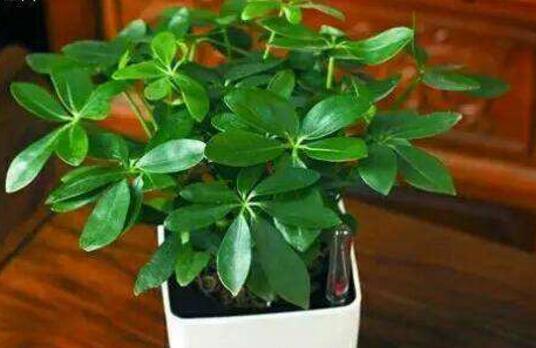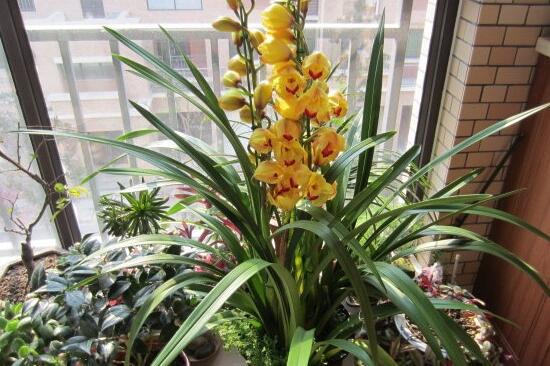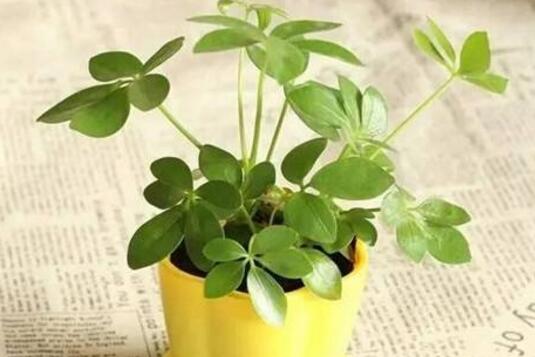How to raise duck foot wood, the breeding method and matters needing attention / light should be suitable.
Duck foot wood is native to Guangdong, South America and other places in China. Because of its strong adaptability and many functions, more and more people raise it. Although this plant is easy to feed, if you want to raise it well, you still need to master certain methods. How to raise it? Let's take a look at the breeding methods and points for attention of duck foot wood.
Is it easy to raise duck feet?

Duck foot wood is a kind of plant that is easy to raise, and it has general requirements for environment and methods. Like the warm, moist semi-sunny environment; the requirement for the soil is fertile acid soil, can withstand slightly barren soil; cold tolerance is strong, the suitable temperature is 16-27 ℃, below 0 degrees may be frostbite, high humidity, exuberant growth, can be said to be very easy to raise.
How to raise duck foot wood
1. Lighting
Duck foot wood can adapt to many kinds of light conditions, such as full sun, half-day, half-shade environment can grow normally, but if you want to make its leaf color more intense green, you need appropriate light, if the light is strong, then the leaf color will be lighter, while in the semi-overcast environment, its leaf color will be green, and the color will be brighter when the light is bright.
2. Soil
Duck foot wood can survive in slightly barren soil, but in its breeding methods and precautions, try to create suitable soil conditions for it, such as fertile, loose, well-drained acid soil is the best, it is best to use a mixture of peat soil, rotten leaf soil and coarse sand.
3. Temperature
Duck foot wood more suitable growth temperature is 16-27 degrees, can grow normally at 30 degrees, but no matter how high the growth may be stagnant, its cold resistance is medium, the temperature when overwintering is not less than 5 degrees, if it is very easy to be frostbitten at 0 degrees, there will be a lot of fallen leaves.
4. Watering
Duck foot wood likes the environment with high humidity, it is more afraid of dry, if the water is more sufficient, its stems, leaves and roots will be very luxuriant, but if there is too much water, there will be rotting roots, so how to raise duck feet on watering? It can be watered once a day in summer, spray water to the leaf surface in dry air, water twice a week in spring and autumn and reduce watering in winter.
5. Fertilization
In March to September, duck foot wood is the fastest growing time, so in the duck foot wood breeding methods and matters needing attention, the fertilization at this stage must be reasonable. Generally, fertilizers are applied every 2-3 weeks, mainly fertilizer, clothing, Hefei and cake.
Matters needing attention in the culture of duck foot wood
1. Shaping and pruning. Duck foot wood is relatively easy to sprout new branches, if the new branches are not pruned in time, the phenomenon of steep growth may occur, so we should pay attention to heart-picking, thinning and so on during maintenance, which can maintain a good plant shape and promote the germination of lateral branches.
2. Change the basin regularly. The nutrients in the soil are limited. When the duck foot wood has been raised for 1-2 years, the nutrients in the soil will be absorbed. In order to maintain enough nutrients, the basin soil needs to be changed regularly, usually every 1-2 years in spring.
3. Control the light. The leaf color of duck foot wood is directly related to the light, so if you want to make the leaf color more beautiful, you need to control the light reasonably. You can give it a semi-shady environment in summer and full sunshine in winter, which can make the leaves more green.
How to raise duck foot wood? Family culture methods and matters needing attention of duck foot wood
The leaves of duck feet are green and luxuriant, and the bright leaves have a very good effect on the greening of the home environment, so many people put duck feet in the living room, study and other places. So, how to raise duck foot wood? Next, I would like to introduce the family breeding methods and matters needing attention of duck foot wood.
Picture: duck foot wood
I. the culture method of duck foot wood
1. Soil selection
The planting soil of duck foot wood requires deep, loose and fertile soil. Family potted plants are generally made of rotten leaf soil or peat soil, pastoral soil, plus 1x4 river sand or perlite. In order to ensure that the soil is fertile, a small amount of cake fertilizer can be added to the soil as base fertilizer.
two。 Upper basin colonization
Choose robust seedlings with well-developed roots and plant them in pots before germination in late autumn or spring. Put a layer of rubble on the bottom of the container before planting, add a small amount of nutritious soil, put the plant into the flowerpot and add a small amount of soil roots to closely combine with the soil. Then pour the water through and compact the soil. After the new plants are planted, they should be placed in the semi-shade for a week, and then gradually transferred to the sun for normal management.
3. Watering management
Duck foot wood grows well in the environment of high air humidity and sufficient soil moisture, daily maintenance, pay attention to timely replenishment of water, but do not accumulate water, otherwise it will cause a large number of fallen leaves, water control should be paid attention to under the condition of low temperature in winter.
If the duck foot wood is maintained in a plastic flowerpot, it should be drained in time, and the soil should be watered without waiting for dryness when watering, and keep the soil moist at any time. When the weather is dry, spray around the plant, pay attention to cover the rain during the rainy season, and avoid stagnant water in the basin.
4. Sunshine temperature requirement
Duck foot wood likes a semi-overcast environment, so it is appropriate to keep it in a place with plenty of bright scattered light, so it is better to put a pot at home. As long as the light at home is bright, you can enjoy it for a long time. In winter, you can move to the south window, and in spring and autumn, you can move the flowerpot to an outdoor well-ventilated place for maintenance for a period of time, but you should pay attention to proper shade so as not to cause the leaves to turn yellow due to sun exposure.
Duck foot wood is not resistant to cold, and the room temperature should be kept above 10 ℃ in winter. If the room temperature is lower than 8 ℃ for a long time, the leaves will gradually wither and yellow, and if it falls below 0 ℃, the leaves will fall off, so it is necessary to control the indoor temperature in the most difficult winter.
Picture: duck foot wood
5. Change basin and trim
Duck foot wood needs to be changed every spring, and if you use plastic pots, you need to pay attention to the loose soil.
Duck foot wood grows fast, and it is easy to sprout and grow branches. An adult plant needs regular shaping and pruning to keep the plant shape neat and beautiful. The duck foot wood, which has been preserved for many years, has perennial old branches and the plant shape is too large, so it can be re-cut in combination with changing pots when the new buds germinate every year to cut off branches, leaves and old roots.
II. Matters needing attention in duck foot wood culture
If the duck foot wood is obtained by cutting, do not rush to change the basin in order to take shape, wait for the obvious growth to change the basin. Usually grow 2-3 grandma to change the basin, and then change the basin once a year.
Create a comfortable maintenance environment. Ensure that the temperature is suitable, drought and waterlogging are suitable, watering is timely, and spraying water to the leaf surface in summer is timely to ensure sufficient light time.
The family breeding methods and matters needing attention of duck foot wood are introduced here. Duck foot wood can smoke secondhand smoke and purify the air. It is a very good household plant and it is worth raising a pot at home.
Breeding methods and matters needing attention of duck foot wood (goose palm wood)
Select the soil suitable for the growth of duck foot wood
The planting soil of duck foot wood requires deep, loose and fertile soil. Family potted plants are generally made of rotten leaf soil or peat soil, pastoral soil, plus 1x4 river sand or perlite. In order to ensure that the soil is fertile, a small amount of cake fertilizer can be added to the soil as base fertilizer.
The method of planting on the pot of duck foot wood
Choose robust seedlings with well-developed roots and plant them in pots before germination in late autumn or spring.
Put a layer of rubble on the bottom of the container before planting, add a small amount of nutritious soil, put the plant into the flowerpot and add a small amount of soil roots to closely combine with the soil. Then pour the water through and compact the soil. After the new plants are planted, they should be placed in the semi-shade for a week, and then gradually transferred to the sun for normal management.
How to water duck foot wood
Duck foot wood grows well in the environment of high air humidity and sufficient soil moisture, daily maintenance, pay attention to timely replenishment of water, but do not accumulate water, otherwise it will cause a large number of fallen leaves, water control should be paid attention to under the condition of low temperature in winter.
If the duck foot wood is maintained in a plastic flowerpot, it should be drained in time, and the soil should be watered without waiting for dryness when watering, and keep the soil moist at any time. When the weather is dry, spray around the plant, pay attention to cover the rain during the rainy season, and avoid stagnant water in the basin.
Sunshine temperature requirement of duck foot wood
Duck foot wood likes a semi-overcast environment, so it is appropriate to keep it in a place with plenty of bright scattered light, so it is better to put a pot at home. As long as the light at home is bright, you can enjoy it for a long time. In winter, you can move to the south window, and in spring and autumn, you can move the flowerpot to an outdoor well-ventilated place for maintenance for a period of time, but you should pay attention to proper shade so as not to cause the leaves to turn yellow due to sun exposure.
Duck foot wood is not resistant to cold, and the room temperature should be kept above 10 ℃ in winter. If the room temperature is lower than 8 ℃ for a long time, the leaves will gradually wither and yellow, and if it falls below 0 ℃, the leaves will fall off, so it is necessary to control the indoor temperature in the most difficult winter.
Change the basin and trim the duck foot wood in time.
Duck foot wood needs to be changed every spring, and if you use plastic pots, you need to pay attention to the loose soil.
Duck foot wood grows fast, and it is easy to sprout and grow branches. An adult plant needs regular shaping and pruning to keep the plant shape neat and beautiful. The duck foot wood, which has been preserved for many years, has perennial old branches and the plant shape is too large, so it can be re-cut in combination with changing pots when the new buds germinate every year to cut off branches, leaves and old roots.
Matters needing attention in duck foot wood culture
If the duck foot wood is obtained by cutting, do not rush to change the basin in order to take shape, wait for the obvious growth to change the basin. Usually grow 2-3 grandma to change the basin, and then change the basin once a year.
Create a comfortable maintenance environment. Ensure that the temperature is suitable, drought and waterlogging are suitable, watering is timely, and spraying water to the leaf surface in summer is timely to ensure sufficient light time.
- Prev

How to raise Cymbidium, the breeding methods and precautions / water of Cymbidium should be watered more.
Cymbidium cymbidium, friends who have seen it should be impressed. It has huge flowers and bright colors, so people like it when they see it. In life, many people want Cymbidium, but many of them are novice, so how to raise Cymbidium is a question that everyone wants to know. To this
- Next

How to raise duck foot wood in winter, four skills to make it survive the winter smoothly / temperature is the key.
Although in the breeding method of duck foot wood, we know that it has a certain ability of cold resistance, but the temperature, light, humidity and other climatic conditions in winter are different from other seasons, so the maintenance and management will also be different, so how to raise duck foot wood in winter? The editor will tell you the method.
Related
- Fuxing push coffee new agricultural production and marketing class: lack of small-scale processing plants
- Jujube rice field leisure farm deep ploughing Yilan for five years to create a space for organic food and play
- Nongyu Farm-A trial of organic papaya for brave women with advanced technology
- Four points for attention in the prevention and control of diseases and insect pests of edible fungi
- How to add nutrient solution to Edible Fungi
- Is there any good way to control edible fungus mites?
- Open Inoculation Technology of Edible Fungi
- Is there any clever way to use fertilizer for edible fungus in winter?
- What agents are used to kill the pathogens of edible fungi in the mushroom shed?
- Rapid drying of Edible Fungi

